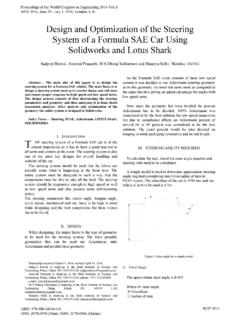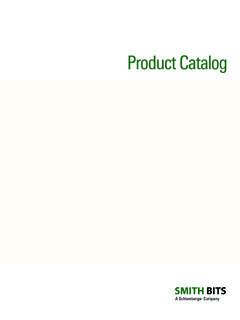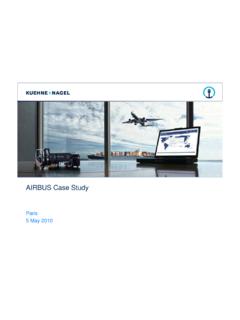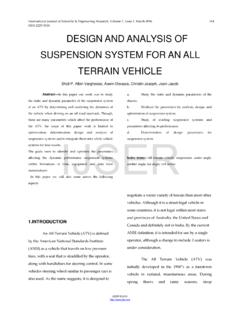Transcription of FLIGHT MANAGEMENT COMPUTER - Mc & RENOX
1 FMC USER S MANUAL 8 - 1 FLIGHT MANAGEMENT COMPUTER TABLE OF CONTENTS SUBJECT PAGE FLIGHT MANAGEMENT COMPUTER CONVENTIONS AND FMC DISPLAY PAGES ACCESSED WITH MODE FLIGHT MANAGEMENT system INTERNAL PRE- FLIGHT INITIALIZATION ARRIVAL / DEPARTURE REVIEWING THE ROUTE OF FIXES AND CUSTOM WAYPOINTS IN THE FMC FLIGHT PLAN FMC TAKEOFF FMC CLIMB FMC CRUISE FMC DESCENT FMC APPROACH FMC FLIGHT REFERENCE AND CREW PMDG 737NG - AOM DO NOT DUPLICATE Revision 23 APR04 8 - 2 FMC USER S MANUAL INTENTIONALLY BLANKR evision 2 APR04 DO NOT DUPLICATE PMDG 737NG - AOM FMC USER S MANUAL 8 - 3 FLIGHT MANAGEMENT COMPUTER CONVENTIONS AND USAGE Overview: The Next Generation 737 uses a fully integrated FLIGHT MANAGEMENT system that is comprised of the following core equipment: Autopilot FLIGHT Director system FLIGHT Control Computers FLIGHT MANAGEMENT COMPUTER CDUs Autothrottle Inertial Reference system Navigation Equipment Together these systems provide a fully automatic, full regime FLIGHT control and information display system .
2 The FMS is capable of providing FLIGHT control from takeoff to rollout. There are two primary tools that crewmembers use to interface with the FMS: the FLIGHT MANAGEMENT COMPUTER /Control Display Units (FMC/CDU) and the Autopilot Mode Control Panel (MCP). The backbone of the FMS is the FLIGHT MANAGEMENT COMPUTER /Control Display Unit. The FMC/CDU performs the following major functions. FLIGHT Planning Navigation Computation Navigation Display Guidance Commands (pitch, roll and thrust) Interface to Inertial Reference system (IRS) Performance Optimization Thrust Limit Calculation Autothrottle Control The FMC takes input and sensory information from many aircraft systems, including the following: FLIGHT Control Computers (FCCs) Air Data COMPUTER Fuel Quantity Indicating system Weight and Balance COMPUTER VOR/DME/ILS Receivers Inertial Reference system Digital Clock Mode Control Panel FMC Database FMC/CDU (Crew inputs) Input from these systems is combined to conduct comprehensive aircraft control calculations.
3 Output from the FMC/CDU is sent to the following systems: Integrated Display system (PFD & ND) Autopilot FLIGHT Director system Mode Control Panel Autothrottle Servo Electronic Engine Controls Launching the FMC/CDU: The Next Generation 737 cockpit has two FMC/CDUs mounted at the forward end of the throttle pedestal. To closely model the functionality of the 737 Next Generation cockpit, the PMDG 737 is capable of displaying two FMC/CDUs on the screen at one time. To activate the captain s FMC/CDU, press the F key on the panel switch device: PMDG 737NG - AOM DO NOT DUPLICATE Revision 23 APR04 8 - 4 FMC USER S MANUAL The second FMC/CDU can be activated on screen by selecting it from the VIEWS/PANELS menu within Microsoft FLIGHT Simulator. Both FMC/CDUs can be operated from within the Virtual Cockpit as well.
4 Each FMC/CDU is linked to it s own FLIGHT MANAGEMENT COMPUTER mounted in the aircraft s electronics bay. Each FMC is comprised of five processors, and integrates data received from the air data sensors, crew input, navigation radios, engine and fuel sensory systems, inertial reference system and internal navigation database. This information is then used to provide steering commands to the autoflight systems in both roll and pitch modes, as well as to the autothrottle servos. Navigation and positional data is provided to the Navigation Display. Each FMC is capable of receiving input independent of the other, and both systems will continually compare input/process results to ensure information consistency on both FMCs. If inconsistencies are detected, a resynchronization process is automatically initiated. FMC/CDU Layout: The FMC/CDU is comprised of a data display screen with six line select keys located on the left and right sides of the screen respectively.
5 The data display screen is capable of showing 14 lines of data 24 characters wide in both large and small fonts. Numeric and Alphabetic keys are provided for crew input. Fifteen function and mode keys are provided to assist the crew in selecting and managing FMC modes. FMC/CDU Display: The MCDU display screen is comprised of 14 data lines capable of displaying 24 characters across in large or small font. The display is broken into three distinct areas: Page Title Line Text Lines (1-6) Scratch Pad The title line is present on every page and describes the current page that is being viewed along with that page s data status. (ACTive, MODified, etc.) The text lines contain information that is aligned against the left and right sides of the display, and can be manipulated by the Line Select Keys. The Scratchpad is where crew data entry will take place.
6 All entries that are made by the crew for entry into the FMC must first be entered into the scratch pad. Revision 2 APR04 DO NOT DUPLICATE PMDG 737NG - AOM FMC USER S MANUAL 8 - 5 Title Line: Top line of the display. Shows title of current page display. You can use this line to tell immediately what page of the FMC you have displayed. Line Select Keys: The FMC/CDU has six LSKs on each side of the screen in order to facilitate data input and manipulation. The keys are identified by their position relative to the display and their sequence from top to bottom. ( The LSKs are identified as either Left or Right and are numbered from 1 to 6 starting at the top.) The LSKs are used for the following functions: Down-selection of data from a particular line to the scratchpad (if the scratchpad is empty.) Data Entry from scratchpad into selected line.
7 Access to data or function identified by LSK. To down-select information into the scratch pad, simply press the LSK next to the data you desire to copy. This will cause the information to be copied to the scratch pad line. To up-select information from the scratch pad to a line in the display, simply press the LSK for the line to which the information is targeted. This will cause the information to be copied from the scratch pad to the desired line in the display. (Obviously, some information cannot be down/up-selected. Most lines that require information input from the crew will accept down/up selection of information, however.) Scratchpad: The last line of the display is a scratchpad which allows for alpha numeric input by the crew, or down-selection of FMC data from other lines. Data Lines: Six pairs of lines that contain data and information.
8 Lines may also contain prompts for data input by the crew. The upper line in each line pair is called the Title Line (small font), while the lower line is called the Data Line (large font). Lines and line pairs are referenced by the associated LSK on either side of the display. (Hence 1L, 2L, 3L or 1R, 2R, 3R, etc.) Display Norms and Prompts: The FMC/CDU has certain norms that, if recognized, make the unit easier to use. PMDG 737NG - AOM DO NOT DUPLICATE Revision 23 APR04 8 - 6 FMC USER S MANUAL Required Entry Boxes: In order to operate, the FMC requires certain information to be entered. Gross Weight, Fuel Reserves and Cruising Altitude are examples of information that the FMC needs in order to operate correctly. Boxes in any FMC/CDU display line indicate that information is required by the FMC. Examples include Gross Weight, Startup Position, etc.
9 LSK Prompts: At any time a < or a > carat is used adjacent to a line select key, this indicates that an additional or related menu can be accessed by pressing the associated LSK. For example, the <INDEX prompt above indicates that pressing the 6L LSK will take you to the INDEX page. Crew Data Entry/Selection Lines: Dashed lines allow for crew entry of specific data which is unique to each individual FLIGHT , such as departure airport, destination airport, speed/altitude restrictions, flap acceleration heights, etc. Page Numbers: Many pages of information contain more information that the FMC/CDU screen is able to show at one time. In these cases, the FMC/CDU will display a page counter at the upper right corner of the screen. (In this case, 1/3 indicates that the display is currently showing screen one of three total screens for POS IDENT.)
10 Using the CLR key: Pressing the CLR key a single time is similar to pressing the backspace key on a conventional keyboard. In order to facilitate erasing the scratch pad, we have added the ability to press and hold the CLR key to delete the entire contents of the scratch pad. To remove all items in the scratchpad, simply press and hold the CLR key for one second. Revision 2 APR04 DO NOT DUPLICATE PMDG 737NG - AOM FMC USER S MANUAL 8 - 7 FMC DISPLAY PAGES ACCESSED WITH MODE KEYS Overview: The PMDG 737: The Next Generation uses an FMC that has fifteen mode keys available on the FMC/CDU. These keys provide direct access to a number of functions within the FMC that will be used by the crew during various phases of FLIGHT . MENU Key: The MENU key provides access to the FMC and other aircraft sub-systems that use the FMC/CDU for input or control.




